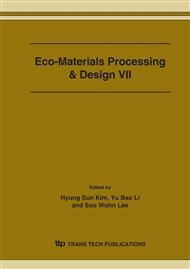p.482
p.486
p.490
p.494
p.498
p.502
p.506
p.510
p.514
The Effect of Cold Equal Channel Angular Process on Texture of Magnesium Alloy (AZ31)
Abstract:
In the present study, we have attempted to refine a microstructure of conventional AZ31 magnesium alloy using a new combination process including hot extrusion followed by a cold equal channel angular pressing (ECAP). ECAP die was specially designed with an inner die corner angle of 135 degree, the fillet angle of 45 degree and dimensional thermo-coupled elastro-plastic material model in order to understand the change of stress and strain of the deformed material after a cold ECAP. ECAP for the AZ31 alloy, which was extruded in the extrusion ratio 20 to 1 and heat-treated at 623K, was successfully carried out at room temperature. The uniform shear band obtained from experiment was well matched with the zone of effective strain more than 0.533 estimated from calculation. On the basis of the results, it is suggested that the room temperature ECAP makes microstructure to be refined and the basal plane to be rotated slightly from extrusion direction to axis direction. Compressive yield strength of AZ31 alloy can be enhanced up to twice in applying ECAP process. Hall-Petch relations do not fit to the experimental data This can be ascribed to the texture effect. Room temperature ECAP process is very promising in improving mechanical properties of AZ31 alloy in terms of grain refinement and texture control.
Info:
Periodical:
Pages:
498-501
Citation:
Online since:
March 2006
Authors:
Price:
Сopyright:
© 2006 Trans Tech Publications Ltd. All Rights Reserved
Share:
Citation:


